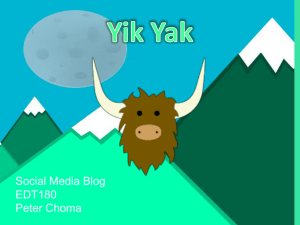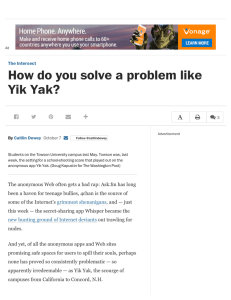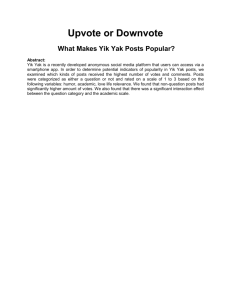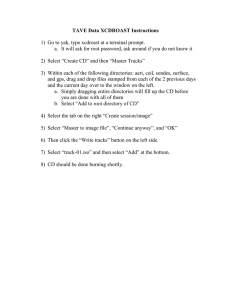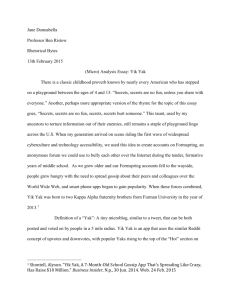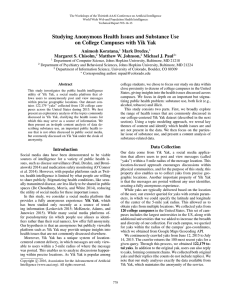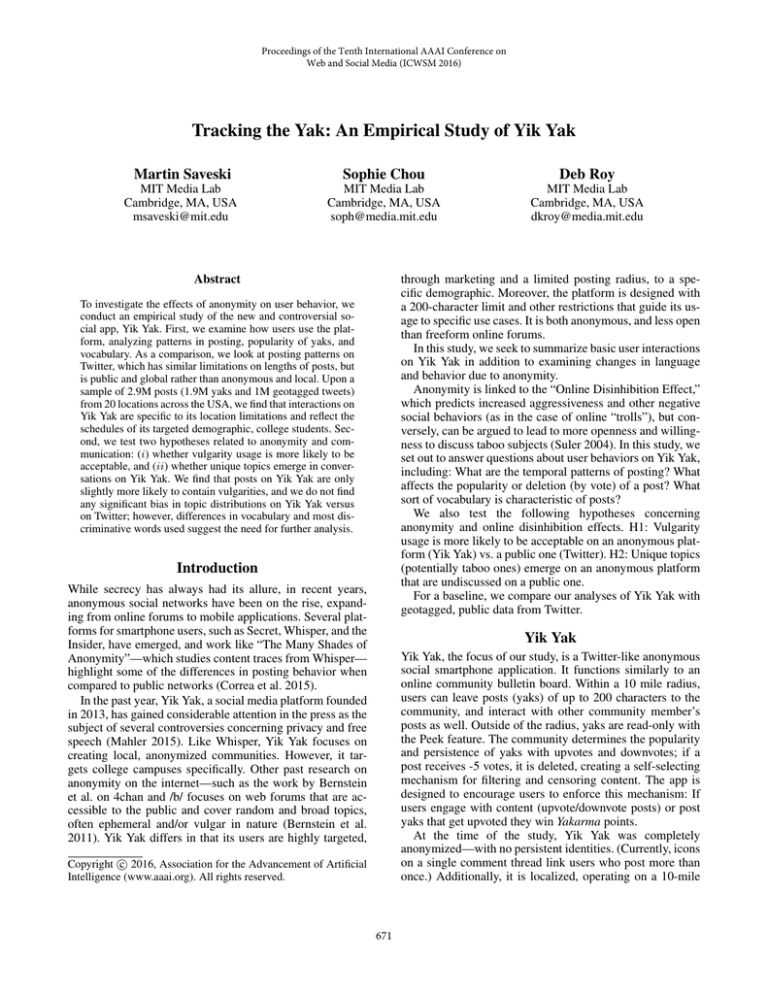
Proceedings of the Tenth International AAAI Conference on
Web and Social Media (ICWSM 2016)
Tracking the Yak: An Empirical Study of Yik Yak
Martin Saveski
Sophie Chou
Deb Roy
MIT Media Lab
Cambridge, MA, USA
msaveski@mit.edu
MIT Media Lab
Cambridge, MA, USA
soph@media.mit.edu
MIT Media Lab
Cambridge, MA, USA
dkroy@media.mit.edu
through marketing and a limited posting radius, to a specific demographic. Moreover, the platform is designed with
a 200-character limit and other restrictions that guide its usage to specific use cases. It is both anonymous, and less open
than freeform online forums.
In this study, we seek to summarize basic user interactions
on Yik Yak in addition to examining changes in language
and behavior due to anonymity.
Anonymity is linked to the “Online Disinhibition Effect,”
which predicts increased aggressiveness and other negative
social behaviors (as in the case of online “trolls”), but conversely, can be argued to lead to more openness and willingness to discuss taboo subjects (Suler 2004). In this study, we
set out to answer questions about user behaviors on Yik Yak,
including: What are the temporal patterns of posting? What
affects the popularity or deletion (by vote) of a post? What
sort of vocabulary is characteristic of posts?
We also test the following hypotheses concerning
anonymity and online disinhibition effects. H1: Vulgarity
usage is more likely to be acceptable on an anonymous platform (Yik Yak) vs. a public one (Twitter). H2: Unique topics
(potentially taboo ones) emerge on an anonymous platform
that are undiscussed on a public one.
For a baseline, we compare our analyses of Yik Yak with
geotagged, public data from Twitter.
Abstract
To investigate the effects of anonymity on user behavior, we
conduct an empirical study of the new and controversial social app, Yik Yak. First, we examine how users use the platform, analyzing patterns in posting, popularity of yaks, and
vocabulary. As a comparison, we look at posting patterns on
Twitter, which has similar limitations on lengths of posts, but
is public and global rather than anonymous and local. Upon a
sample of 2.9M posts (1.9M yaks and 1M geotagged tweets)
from 20 locations across the USA, we find that interactions on
Yik Yak are specific to its location limitations and reflect the
schedules of its targeted demographic, college students. Second, we test two hypotheses related to anonymity and communication: (i) whether vulgarity usage is more likely to be
acceptable, and (ii) whether unique topics emerge in conversations on Yik Yak. We find that posts on Yik Yak are only
slightly more likely to contain vulgarities, and we do not find
any significant bias in topic distributions on Yik Yak versus
on Twitter; however, differences in vocabulary and most discriminative words used suggest the need for further analysis.
Introduction
While secrecy has always had its allure, in recent years,
anonymous social networks have been on the rise, expanding from online forums to mobile applications. Several platforms for smartphone users, such as Secret, Whisper, and the
Insider, have emerged, and work like “The Many Shades of
Anonymity”—which studies content traces from Whisper—
highlight some of the differences in posting behavior when
compared to public networks (Correa et al. 2015).
In the past year, Yik Yak, a social media platform founded
in 2013, has gained considerable attention in the press as the
subject of several controversies concerning privacy and free
speech (Mahler 2015). Like Whisper, Yik Yak focuses on
creating local, anonymized communities. However, it targets college campuses specifically. Other past research on
anonymity on the internet—such as the work by Bernstein
et al. on 4chan and /b/ focuses on web forums that are accessible to the public and cover random and broad topics,
often ephemeral and/or vulgar in nature (Bernstein et al.
2011). Yik Yak differs in that its users are highly targeted,
Yik Yak
Yik Yak, the focus of our study, is a Twitter-like anonymous
social smartphone application. It functions similarly to an
online community bulletin board. Within a 10 mile radius,
users can leave posts (yaks) of up to 200 characters to the
community, and interact with other community member’s
posts as well. Outside of the radius, yaks are read-only with
the Peek feature. The community determines the popularity
and persistence of yaks with upvotes and downvotes; if a
post receives -5 votes, it is deleted, creating a self-selecting
mechanism for filtering and censoring content. The app is
designed to encourage users to enforce this mechanism: If
users engage with content (upvote/downvote posts) or post
yaks that get upvoted they win Yakarma points.
At the time of the study, Yik Yak was completely
anonymized—with no persistent identities. (Currently, icons
on a single comment thread link users who post more than
once.) Additionally, it is localized, operating on a 10-mile
c 2016, Association for the Advancement of Artificial
Copyright Intelligence (www.aaai.org). All rights reserved.
671
A
B
Twitter
YikYak
YakYak
Twitter
7PMVNF
FractionofPosts
Midnight
Noon
Yaks
Tweets
Penn State University
MIT / Harvard / Simmons College
University of Florida
University of Texas Austin
University of Michigan Ann Arbor
US Santa Barbara
University of Illinois at Urbana C.
Carnegie Mellon University
University of Wisconsin Madison
Purdue University West Lafayette
Syracuse University
UC Berkeley
University of Iowa
Georgia Institute of Technology
Cornell University
University of Pennsylvania
Brown University
West Virginia University
Lehigh university
Dartmouth College
9 AM
Mon
3 AM
6PM
TimeofDay
Tue
Wed
Thu
Fri
Sat
Sun
Day
Figure 2: Daily (A) and weekly (B) activity patterns on Yak
Yak (green) and Twitter (blue).
0.07
107
A
100
150
200
250
Number of posts (Thousands)
103
10
0
10
1
10
Numberofreplies(log)
Figure 1: Locations selected for the study and the volume of
yaks and tweets in each.
0.25
0.04
0.03
0.02
2
0.00
0.20
0.15
0.10
0.05
0.01
101
C
0.30
0.05
105
Probability
50
0.35
B
0.06
Probability
0
Frequency(log)
Slope: -2.71
0
5
10
15
0.00
0
Rating
5
10
15
Rating
Figure 3: Yik Yak. (A) Distribution of number of replies per
post. (B) Distribution of ratings (number of upvotes/downvotes) of posts. (C) Distribution of ratings of post replies.
radius, mostly surrounding college campuses. Users can upvote, downvote, and reply to yaks. The target demographic is
young, with marketing efforts heavily directed towards college campuses (Shontell 2015).
Conversely, Twitter enables users to send short 140character limited tweets. Users on Twitter have a persistant
username and identity, which can be a pseudonym or a real
id, or an organization. A portion of users are “verified”, or
tied to their real ids. Specific to Twitter are various conventions such as @mentions, #hashtags, and the sharing of urls,
all of which are not available on Yik Yak. The demographic
of Twitter is less specific than the targeted audience of Yik
Yak. Also, Twitter does not provide a self-selecting mechanism for filtering and censoring content, but allows users to
favorite tweets and report posts that they find inappropriate.
Although, Yik Yak and Twitter are different in many aspects, using Twitter as a baseline allows us: (i) to put the
results in perspective, and (ii) help future researchers understand how their existing work on Twitter—which is commonly studied—relates to this new platform.
Temporal Activity Patterns
Daily patterns. Figure 2A shows the posting activity on Yik
Yak and Twitter during different times of the day. Yik Yak
users start to post around 8-9am, reaching a plateau around
noon. There is a steady volume of posts during the afternoon,
followed by a peak around midnight. The volume decreases
late at night. In contrast, Twitter users tend to post earlier
in the day, starting from 7-8am. The peak of the activity is
around 9pm, three hours earlier than on Yik Yak.
Weekly patterns. Figure 2B shows the posting activity during different days of the week. The volume of tweets is
steady across the week, with a slight decline of 1% on Sundays. In contrast, the volume of posting activity on Yik Yak
is highest on weekdays, with a peak on Wednesdays and
Thursdays, and declines during weekends. This may be specific to Yik Yak’s target demographic, college students, who
travel home during the weekends. It is worth noting that we
collected posts from only 19 days and that these patterns
may vary depending on the time of year.
Data Collection
Yik Yak Posts and Replies
We collected data from 30 hotspots over a duration of 19
days: Monday, April 4th to Friday, April 24th, 2015. For variety, we sampled from Newsweeks lists: top 10 engineering
schools, top 10 women’s colleges, top 10 party schools, and
the Ivy League. After data collection, we narrowed the list
down to 20 colleges due to sparse data in some locations, and
an overlap of radiuses in others. Figure 1 shows the final set
of locations and the volume of yaks and tweets in each.
For Yik Yak, we set up scrapers to run in 5-minute intervals, with a 12-hour lookback to collect replies. For Twitter,
we approximated Yik Yak hotspots by looking at geotagged
tweets in a 10-mile radius around the same locations. We
used the GNIP Historical API to retrieve all public tweets
posted in these locations. Finally, we ended up with 1.9M
yaks (569K posts and 1.4M replies) and 1M tweets.
Replies. As mentioned in the previous sections, users on Yik
Yik can reply on posts. We find that the distribution of number of replies per posts follows a power law (Figure 3A). In
other words, most yaks have few replies and there are a few
posts with a lot of replies. The platform is relatively social:
every post has on average two replies. In comparison, out of
all tweets we collected every third was a reply (note that we
did not explicitly collect the replies of the tweets).
Ratings. Users can also rate (upvote or downvote), both
posts and replies. Only a small fraction, 6.4%, of posts are
not rated, meaning they have a rating of zero (Figure 3B).
Most posts, 74.4% have positive ratings and only 19.2%
have negative ratings. It is worth noting that we were not
able to capture banned posts, i.e., posts with ratings below
672
know student
freshman upvote
saying
honestly relationship friendshorny
engineering
friend greek
finals
gay pink maybe
everyone
balloon
person
compass
aren
yellow
pike also sailboat
gpa
major
yeah study
isn
hook
girlfriend
logan
binoculars
comment
anyone
roommates
feel guys sex someone
exam
boyfriend doesn fuck yik
dating
hot
sunday
museum
fenway
trending
city center
2015
birthday
station baseball
coffee
eatingndastreets313
giants
park twitter team
hotel
follow
ass
providence
niggas airport
niggatweetphiladelphia
fan
yall
college
flight
classes actually
icon acorn
racist
white
purple
yikyak
probably
iphone
nurse
flashlight
porn
asian
post
think
series
well
mean h2p
comments
almost
lmao
haha
showbit
house
album apr
fans
atlanta
song
phillies
conference
1st jenner supplemental
trends
easter
intersection
finals way
also never
always
top20
pretty netflix
much
sure
may
ask
pizza
feeling
don keep
time sleep things
week friends
lot great
weeks find
depression
makes
day
start
classes
year luck feels
depends appreciate
hope
struggle exams done helps grades times happy professor
procrastination
awesome
mike hartsfield
summer
actually
bed talk well
feel
yeah life
though love together roommate
madison
ladies
might
nap contact
thank someone
anxiety
asleep
good study
definitely
work yes
finally
awkward hours
sometimes long
play favorite
ready
new san report atl tonight day tweets bar
gotta bout aint international playoffs lil
video
love
bruce
late
friend
really alone hug
semester
even
oakland
church
000
anchor sometimes frat socks tinder yaks
attractive studying college
boot shovel
sorority penis
sexual else
yakarma
mushroom
really
find
ave
ima
playoff
grades
semester
games
years
thanks
thought
probably
minutes
coach
smh
sox
home
people dick girls
great austin
via event
game ain boston today
yak roommate
philly
don guyclass want girl campus win francisco
professor
exams
sounds motivation
studying relationship early
class h2p
tweeting
season wit photo pittsburgh
theatre
prom
usually months
worry
nigga tonight
jason
rape
sigma
kim
chris
george
carry
anybody
blacks
ike
theta
hilary smith
ross
matt
sig
frank
sailboat
mary
party
jerry
rand
phi
kappa
slut
reee
wen
aaron
chase
jenna mike
niggas potter
burge jews
windy ted
cunningham
hernandez
michael
yak
liberal
geeds
cathy gun
zbt
scott
austin
ass black
girls jimmy
downvote
tiny
stfu
suck
fuckhitler
john
vote hillary
storm bit
women
joe dick yeti
indians
cock
david
white page pussy
racist
ann
geed
jack dtf
steve
feminists
utunrated
walker jon gay wanna
james
madison bitch cunt
middle kik santa
pike paul fat anyone
ben sunny
thomas
bitches
snapchat
asshole sammy
clinton
addy taylor 420
snap harry president
weed
jackson
sean
racism
asian
liberals
retarded
Figure 4: Words characteristic for Yik Yak (left) and Twitter
(right). The size of the words is proportional to how characteristic they are to the specific platform.
Figure 5: Top 100 most characteristic words for upvoted
(left) and downvoted (right) yaks. The size words is proportional to how strongly associated they are to the class.
-4, as they immediately disappear from the timeline. This
suggests that the rating feature is heavily used, which leads
to community content filtering. In contrast, about one third
of all replies are not rated (Figure 3C). Those that are rated,
are mostly rated positively (61.5%), and only 7.7% have
negative ratings.
5.38% of all tweets contain vulgar words. The difference is
highly statistically significant (p < 0.05 on both χ2 test of
independence and McNemar test) due to the large sample
size, but substantively very small, less then 1% or 17%
relative increase.
On Yik Yak posts are more likely to have vulgar words
(8.9%) than replies (5.2%). We also looked at how Yik Yak
users respond to offensive posts and replies. We find that
yaks that contain vulgar words are 38% more likely to be
downvoted and have negative ratings: 14.9% of all yaks that
contain vulgar words have negative ratings, whereas 10.8%
of yaks without vulgar words have negative ratings. Furthermore, if we focus on yaks with lowest ratings (-4), they are
61% more likely to contain vulgar words.
This contradicts our first hypothesis: We find that on
anonymous platforms users are only slightly more likely to
use vulgar language than on public ones, and when they do
it is not acceptable and leads to negative feedback.
Content Analysis
Yaks versus tweets. Next, we analyze the differences in
language use between Yik Yak and Twitter. We use Mutual Information (Hutter 2002) to find the most characteristic
words for each platform. This metric selects words that are
frequent, but also distinctive for the specific platform. Figure 4 shows the top 100 most characteristics words for each
platform. The size of the words is proportional to their Mutual Information score, thus the more characteristic a word
is to Yik Yak or Twitter, the larger it appears.
The Yik Yak word cloud is dominated by words specific to college life, such as: campus, roommate, studying,
girls, guys, relationships. In contrast, the most characteristic
words for Twitter are names of cities: Philadelphia, Boston,
Austin, and sport related words: team, game, playoffs.
Community Filtering and Rewards. These results contradict previous findings on anonymous online platforms such
as: 4chan—where inappropriate language is considered acceptable (Bernstein et al. 2011), and Whisper—where 18%
of all posts are deleted by moderators (Wang et al. 2014).
We posit that there are two key characteristics of the Yik
Yak platform that lead to this difference in behavior: (i) a
community filtering mechanism, and (ii) a reward system
that enforces this mechanism and biases it in a positive way.
The empirical evidence that vulgar posts are more likely
to be downvoted and eventually banned suggests that the
community filtering mechanism is at work. We believe that
this mechanism is fueled by the Yakarma: a user score on the
Yik Yak app. Users win Yakarma points if they post or reply
(+2 points), upvote or downvote other posts (+1 point), or if
their posts get a reply (+1 point) or an upvote (+1 point),
but lose Yakarma points when their posts are downvoted
(−2 points). This encourages users not only to engage with
content and enforce the community filtering mechanism, but
also to post content that is appropriate and leads to engagement and upvotes.
The combination of community filtering and rewards creates an environment where positive social norms emerge. It
fosters the positive aspects of the online disinhibition effect
and sanctions the negative ones. This is in contrast to other
anonymous platforms, such as 4chan, where vulgar language
is the social norm and part of the user group identity.
Upvoted versus downvoted yaks. In a social app with no
linked identities such as Yik Yak, there is a question of
whether or not community filtering mechanisms still operate to censor harmful content. Although only the user who
posted the yak can delete it at will, the Yik Yak community
can also remove content that is unpopular by downvoting:
yaks with a cumulative sum of -5 votes are removed. By
examining the most characteristic words of upvoted versus
downvoted yaks, we are able to visually infer some basis of
community filtering.
Figure 5 shows word clouds of the top 100 most characteristic words for upvoted and downvoted yaks, again selected
using the Mutual Information criterion. The word cloud for
upvoted yaks contains mostly general and slightly positive
words, such as: thanks, luck, love. On the other hand, the
word cloud for downvoted yaks contains mostly inappropriate and racist words.
Usage of Vulgarities
We collected a list of 355 vulgar words from
www.noswearing.com and scanned all posts, tweets
and yaks. Interestingly, we find that posts on Yik Yak are
only slightly more likely to contain vulgar words than
posts on Twitter: 6.29% of all yaks (posts and replies), and
673
1.0
Fraction of Yaks/Tweets that belong to this topic
Topic Modeling
One of the key hypotheses regarding anonymous social platforms is the question of whether they encourage significantly different topics of discussion, either to negative (deviant) effect, or positive (encouraging) conversation. To test
this assumption, we ran a topic model on the combined corpus of both tweets and yaks. Then, we assigned each document (either a tweet or a yak) to the derived topics and
checked whether there are any topics that are dominated by
only one platform. Using a Latent Dirichlet Allocation (Blei,
Ng, and Jordan 2003) model with 200 topics, we did not see
a significant amount of topics that belonged heavily to one
platform and not the other. We also experimented with different number of topics and we found similar results. Figure
6 shows the sorted ratios of documents belonging to topics
1-200 in either platform.
This refutes our second hypothesis: We find that, on average, topics tend to be evenly split across both platforms and
that there are no topics that are unique to Yik Yak.
Although this counters expectations of the effects of
anonymity, we offer three possible explanations to this finding. (i) The bulk of both yaks and geotagged tweets center
around local events and transactions. As seen in Figure 4,
the majority of characteristic words for tweets are referring
to cities or event venues. Although characteristic words for
yaks do not include mentions of locations by name, the platform is designed specifically for local interactions. (ii) Twitter does not impose real name policy for usernames, and it
may be that users use anonymous accounts (pseudonyms) to
post about more sensitive topics. Previous studies show that
25.9% of all accounts are fully or partially anonymous (Peddinti, Ross, and Cappos 2014). (iii) Geotagged tweets might
pose additional privacy threats to users (Mao, Shuai, and Kapadia 2011); thus users who share their location on Twitter
might be less concerned about their privacy and feel comfortable to discuss sensitive topics publicly.
0.9
0.8
0.7
0.6
0.5
0.4
0.3
0.2
0.1
0.0
1
10
20
30
40
50
60
70
80
90
100 110 120 130 140 150 160 170 180 190 200
Topic #
Figure 6: LDA topic modeling with 200 topics. The colors
show the proportion of tweets (blue) and yaks (green) that
belong to each topic. Topics are evenly split across both platforms and there are no topics that are unique to Yik Yak.
event, etc. Finally, on both platforms, we collected data from
a short period of time, 19 days. Patterns of behavior may also
vary depending on the time of year.
Future Work. Our analysis serves as a preliminary study of
Yik Yak, and opens up many avenues of future work. In this
study, we collected yaks from 20 different hotspots, but we
aggregated the data in our analyses. In our next steps, we are
interested in exploring how topics vary in each location, and
whether any unique ones emerge specific to certain schools
or regions. Similarly, looking for correlations between the
characteristics of the schools (demographics, academic success, etc.) and usage of Yik Yak (linguistic characteristics,
usage patterns) would show the promise of the platform as a
social signal.
References
Bernstein, M. S.; Monroy-Hernández, A.; Harry, D.; André, P.;
Panovich, K.; and Vargas, G. G. 2011. 4chan and/b: An analysis of anonymity and ephemerality in a large online community. In
ICWSM.
Blei, D.; Ng, A.; and Jordan, M. 2003. Latent dirichlet allocation.
JMLR.
Correa, D.; Silva, L. A.; Mondal, M.; Benevenuto, F.; and Gummadi, K. P. 2015. The many shades of anonymity: Characterizing
anonymous social media content. In ICWSM.
Hutter, M. 2002. Distribution of mutual information. NIPS.
Mahler, J. 2015. New york times: Who spewed that abuse? anonymous yik yak app isnt telling. (Visited on 01/07/2016).
Mao, H.; Shuai, X.; and Kapadia, A. 2011. Loose tweets: an analysis of privacy leaks on twitter. In WPES.
Peddinti, S. T.; Ross, K. W.; and Cappos, J. 2014. On the internet,
nobody knows you’re a dog: a twitter case study of anonymity in
social networks. In COSN.
Shontell, A. 2015. Business insider: How 2 georgia fraternity
brothers created yik yak, a controversial app that became a ∼$400
million business in 365 days. (Visited on 01/07/2016).
Suler, J. 2004. The online disinhibition effect. Cyberpsychology &
behavior.
Wang, G.; Wang, B.; Wang, T.; Nika, A.; Zheng, H.; and Zhao,
B. Y. 2014. Whispers in the dark: analysis of an anonymous social
network. In IMC.
Discussion and Conclusion
Key findings. In our study of Yik Yak, we set out to test two
main hypotheses related to anonymity and behavior. We find
that vulgarity usage increases only slightly in secrecy, and
furthermore, posts containing offensive language are more
likely to be downvoted. This suggests that self and community censoring exists even in anonymity, and that communities on Yik Yak create a self-regulating mechanism through
which vulgar comments are given negative feedback. In our
analysis of content, we do not find any topics that are specific
to Yik Yak. However, we see posting patterns and vocabulary that is indicative of the college-centric user base.
Limitations. Our study suffers from three main limitations.
First, we are missing the content of banned yaks as they
are removed immediately after they reach a rating of -5.
They may contain unique topics or allow us to further investigate the community censoring hypothesis. Second, we
considered only geotagged tweets, which comprise only a
small fraction of all tweets and may not be a representative
sample of Twitter. Notably, geotagged tweets may represent
specific usages, such as declaring traveling, attendance at an
674

